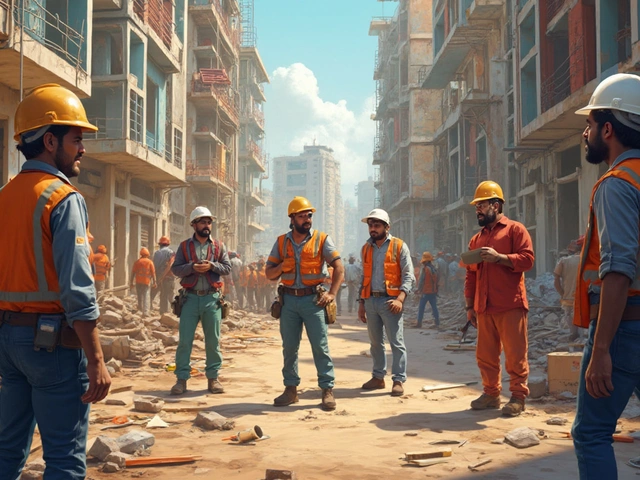Ever tried to figure out what an architect actually does beyond sketching cool buildings? It's not just about drawing or picking fancy tiles. Everything starts with a solid plan, and the process runs through five main services that shape every project—whether you're remodeling your kitchen or building an office tower.
Knowing these core services helps you avoid surprises and communicate what you really want. It also saves money and time, since you’ll understand who’s in charge at each stage. Too many people jump in thinking the architect just “does the plans,” but you’ll see it’s way more hands-on than that.
Each service covers its own set of tasks. From figuring out what’s even possible on your land, to dealing with permits, and finally making sure the contractor doesn’t mess up your vision. Missing a step can lead to headaches and blown budgets—something no one wants, especially when every dollar counts.
- Project Planning: Laying Down the Groundwork
- Design Development: From Sketches to Blueprints
- Construction Documentation: Getting Ready to Build
- Bidding & Negotiation: Securing the Right Team
- Construction Administration: Bringing the Project to Life
- Choosing the Right Services for Your Project
Project Planning: Laying Down the Groundwork
This is where every smart building project starts. Before any sketches or models, architects help you figure out what’s possible on your site, what rules you need to follow, and how to avoid nasty surprises later. If you skip this phase, you’ll likely run into delays, weird legal issues, or massive budget problems.
First off, architects will meet with you to pin down what you actually want and need. It’s called a “program,” and it gets pretty detailed—how many rooms, budget range, future plans, design vibes, and even storage needs. This is also when they look at your land or existing building to check its perks and limits.
They’ll dig into things like:
- Local building codes and zoning laws (for example, how tall can your building be? How far must it sit from the property line?)
- Utility hookups (Is there enough water or electricity for your dream home? Is sewer access a pain?)
- Site conditions, like sunlight, wind, trees, and soil stability. A rocky site or shady lot changes everything.
- What permits you’ll need and typical timelines for approval in your area
During project planning, a good architect is already looking out for your wallet. They’ll mention where to save money and highlight any “hidden costs,” like upgrading old wiring or removing an underground tank. Most people don’t think of these until it’s too late.
If you want a quick tip: bring as much info as you can to that first meeting—surveys, photos, rough ideas, or even your Pinterest obsessions. The more details, the smoother this phase goes, and the less you risk scope creep down the line.
Design Development: From Sketches to Blueprints
This is where things start feeling real. Gone are the vague sketches from the earlier ideas phase—now it’s about turning those scribbles into clear, workable plans. At this stage, the architect takes your wish list and mixes it with detailed measurements, materials, and all the stuff that makes a building safe and functional. It’s a team effort too; engineers, interior designers, and sometimes even landscape folks jump in for input.
Here's how the architectural services world usually handles design development:
- Refining floor plans and layouts: This means thinking through every room’s size, window placement, and traffic flow. You’ll see 2D drawings start to look like something you’d find in a builder’s office.
- Choosing materials: Brick or stucco? Hardwood or tile? Architects offer suggestions based on look, cost, and how a material holds up over time.
- Coordinating systems: Layouts for plumbing, electrical, and air conditioning all get worked into the plans. No point in a fancy living room if you forgot the AC vents!
- 3D models and visualizations: Tools like Revit and SketchUp let you or your contractor see the building before it’s made. This helps catch problems early.
You’ll get a good sense of the budget now too. According to the American Institute of Architects, around 75% of design decisions are pinned down in this phase—so this is the time to speak up if you don’t like something.
| Project Type | Timeline (Weeks) | % of Total Design Fees |
|---|---|---|
| Residential (House) | 4–8 | 20–30% |
| Commercial (Office/Retail) | 8–12 | 18–25% |
Pro tip: This is your shot to make changes before things get locked in. Once the project moves to detailed drawings for construction, tweaks get more expensive and time-consuming. Ask lots of questions and don’t be shy about voicing concerns—your future space depends on it.
Construction Documentation: Getting Ready to Build
This is where the rubber meets the road. Once you and your architect nail down the design, it’s time to get all those ideas on paper—real, detailed documents that builders rely on to do their job right. These docs are what turn a cool sketch into something your contractor can follow without guessing.
Construction documentation covers the full set of drawings, notes, and technical details. The architect creates everything from floor plans and electrical layouts to window details and door schedules. It’s not just about making it look good—each part spells out exactly what needs to be built, what materials to use, even where the plumbing runs.
"Without thorough construction documents, projects have a 40% higher risk of delays and budget overruns." – American Institute of Architects (AIA) Best Practices, 2023
Builders use these docs for permits too. Most cities won’t even look at your project unless you’ve got the full set. The cool thing is, good construction docs clear up confusion before anyone picks up a hammer.
Here’s what usually gets included in a full construction documentation package:
- Detailed dimensioned floor plans
- Elevations and cross-sections
- Structural, electrical, and mechanical layouts
- Material specifications (like what finishes go where)
- Schedules for windows, doors, and hardware
- Notes and details on how things get built
An interesting fact: most permit offices in the U.S. reject drawings on the first go at least 30% of the time because they’re missing details like fire ratings or accessibility info. So, don’t shortchange this step. Quality here means fewer headaches down the road.
| Type of Doc | Why It Matters |
|---|---|
| Site Plan | Shows how the building fits the land, meets setbacks, and avoids zoning issues |
| Floor Plan | Gives clear layout for every room—used by all trades |
| Sections | Shows walls, roofs, and connections—nails down construction details |
| Specs | Lists brands, models, finishes, and standards for every component |
This part of the process is the backbone of architectural services. It sets the tone for the build and can make or break how smoothly your project runs. Always review your documents with your architect before sending them off. Ask questions, double-check details, and make sure you understand what’s being built. It could save thousands in mistakes later.

Bidding & Negotiation: Securing the Right Team
This is where the rubber meets the road. After all those drawings and plans, you need someone to actually build your project. The architectural services world calls this stage "bidding and negotiation," and it matters more than people think. Messing up here is a fast way to blow your budget or end up with a contractor who ghosts when issues pop up.
Here’s what happens: your architect preps a stack of documents—the design plans, specs, and any must-follow instructions. They send these out to builders (contractors) who want the job. These contractors review everything and give you their best price, timeline, and sometimes even ideas to save money. Don’t just go with the lowest bid—the cheapest can sometimes mean cut corners or surprise fees later.
During this stage, architects don’t just sit back. They answer contractor questions, run background checks, and help you compare the quotes. Most will flag stuff like if one bid is missing electrical costs or if someone’s proposing questionable materials. They’re looking out for you, not just the bottom line.
Negotiation comes next. You can clarify expectations, ask for small changes, and tighten costs or schedules. Good architects are tough negotiators—they know the red flags and can talk contractors into fair deals without pushing them out the door.
If local law needs it (like on public projects), this process might be strictly regulated. Most private projects are more flexible, but it’s smart to follow a clear process. Here are a few top tips:
- Never pick a contractor without references—check recent jobs and speak to old clients.
- Ask your architect if any bid seems “too good to be true.” Spoiler: it probably is.
- Always get everything in writing, from costs to schedules to who handles permits.
- Let your architect manage communication, so details don’t get lost in translation.
Pick the right team here, and everything else gets easier. Get it wrong, and you’ll spend more time fixing problems than watching your ideas come to life.
Construction Administration: Bringing the Project to Life
This is the part where your drawings stop being ideas and start turning into something you can actually walk through. Construction Administration isn’t about swinging hammers—it's about keeping your project on track, solving problems fast, and making sure the final product matches the plans your architect put together.
Your architect acts like your project’s watchdog at this stage. They visit the site, answer contractor questions, and double-check the work. Even the best contractors miss things sometimes, so this step is how expensive mistakes get caught early. The architect does things like:
- Reviewing shop drawings and material samples from your builder (brick type, tiles, lighting—you name it).
- Managing requests for information, because contractors will always have questions once boots hit the dirt.
- Visiting your site regularly to spot issues before they get costly.
- Checking that the work matches the approved plans and local codes.
- Signing off on payments so you aren’t shelling out cash until the job is done right.
One big takeaway here: architects help prevent "design drift," where your original vision starts to disappear because of quick fixes or shortcuts. Even small changes—like swapping a window or moving a wall—can mess with the whole project, so you need that extra set of eyes.
You might be thinking, "Do I really need all that?" Well, according to the American Institute of Architects, projects with architects handling construction administration see a 27% drop in major errors that need re-work. That’s less headache for everyone—plus lower costs in the long run.
| Task | Why It’s Needed | Who’s Involved |
|---|---|---|
| Site Visits | Catch mistakes early | Architect, Contractor |
| Shop Drawing Review | Keep materials as planned | Architect |
| Responding to RFIs | Clarify any plan questions | Architect, Contractor |
| Payment Approvals | Pay only for finished, correct work | Architect, Owner |
Here’s a tip: Get clarity upfront on how often your architect will be on site and what their role covers. Some projects need weekly check-ins, and others can get by with less. If you skip construction administration, you're basically hoping everything goes as planned—and anyone who’s ever built so much as a backyard shed knows that never happens.
Always keep the architectural services piece in your contract clear so you’re not left arguing about what’s covered midway through the build.
Choosing the Right Services for Your Project
Picking the right architectural services isn’t just about hiring someone to draw a building. Each type fits a different need, and what works for your neighbor may not work for you. About 70% of new homeowners regret not getting more input from their architect, according to a 2023 HomeAdvisor report. That’s a lot of missed chances for smarter decisions.
First, figure out your project’s actual size and goals. Building a shed or small addition? You probably don’t need the full package, but might want help with permitting and basic design. Doing a full-scale reno or custom home? You’ll want the whole process, start to finish.
- Project Planning: Perfect for when you’re stuck at the idea stage. Don’t know if your lot can handle another floor? An architect’s feasibility study could save you wasted effort later.
- Design Development: Maybe you already know what you want—something modern, open, and light-filled. This service gets your must-haves into a real design and clears up local code headaches before you get too far.
- Construction Documentation: Thinking of DIY-ing? You still need solid plans for permits and for builders who need straightforward instructions.
- Bidding & Negotiation: If you want to avoid getting ripped off or hiring the wrong people, let your architect help sort the bids and check contracts. Too many folks just accept the lowest number and regret it.
- Construction Administration: For anyone short on time or worried about mistakes, this step gives you an expert checking if the contractors are actually following the plan.
Also, compare how much each service usually costs. Here’s a rough breakdown for common home projects in the U.S. in 2024:
| Service | % of Total Project Cost |
|---|---|
| Project Planning | 2-5% |
| Design Development | 5-10% |
| Construction Documentation | 10-15% |
| Bidding & Negotiation | 1-2% |
| Construction Administration | 3-5% |
Think of hiring modular—use what you need. Always ask to see your architect’s portfolio of similar work. Some architects are great with commercial jobs but have never done a tricky hillside home. Others make killer plans for tiny urban lots. Don’t be shy about asking how hands-on they’ll be—or if they’ll simply hand off the plans and disappear.
If you’re on a tight budget, bundle only the essentials. But don’t skip the basics—dropping documentation or permits can lead to major headaches down the line, including fines or costly rebuilds. As always, read every agreement carefully and know exactly what’s included before you sign anything.






